Approve or unapprove a component
You can let other Inspire users know if a component is in a state of completion by giving it an approved state. You can also set an unapproved state to let other users know the component is still in draft form. You can set this state if you are an administrator, if you have permissions to update the component, or if special permissions are required, you have been added to the Content Browser's can_approve module property.
Manage approval states: You can approve and unapprove a component in the following places:
- Components browser: Look for any green icons before the name of the component.

 Approve a component in the browser
Approve a component in the browser Unapprove a component in the browser
Unapprove a component in the browser
- Oxygen map editor: Look for any green icons in the left Outline panel. They are shown by an icon after the name of the component.
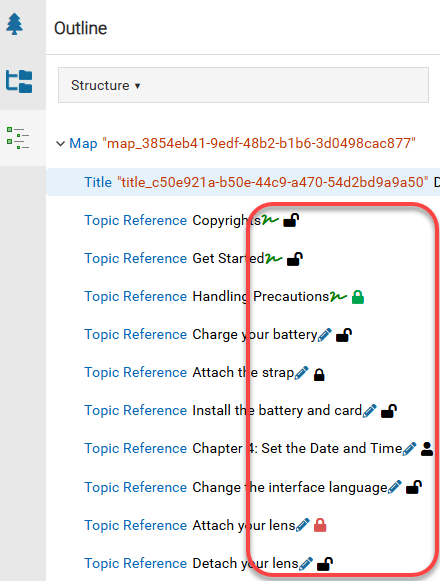
 Projects: In any of the following places: the right-click menu, the
Projects: In any of the following places: the right-click menu, the  the Options menu, and the Selected components panel.
the Options menu, and the Selected components panel.

Approval icons used in Inspire:
 You can be required to attach your electronic signature when approving a component. If authenticated, the component may be locked with
You can be required to attach your electronic signature when approving a component. If authenticated, the component may be locked with  a green system lock.
a green system lock.  An administrator can control if a system lock is placed on the component after a user approves it. By default, this optional feature is set to false, and a lock is not placed on a component after approval.
An administrator can control if a system lock is placed on the component after a user approves it. By default, this optional feature is set to false, and a lock is not placed on a component after approval.  When you approve a component, if an electronic signature isn't required, then you see a green check mark. The component may be locked with
When you approve a component, if an electronic signature isn't required, then you see a green check mark. The component may be locked with  a green system lock.
a green system lock. An administrator can control if a system lock is placed on the component after a user approves it. By default, this optional feature is set to false, and a lock is not placed on a component after approval.
An administrator can control if a system lock is placed on the component after a user approves it. By default, this optional feature is set to false, and a lock is not placed on a component after approval.  A component has a state of unapproved (also known as the draft state) if it has a blue pencil icon. When you create a new topic, components are given this draft state by default.
A component has a state of unapproved (also known as the draft state) if it has a blue pencil icon. When you create a new topic, components are given this draft state by default.

 The open lock is used when a component isn't being edited by another user, isn't in use by Inspire, or approved.
The open lock is used when a component isn't being edited by another user, isn't in use by Inspire, or approved. The closed lock is used when a component is being edited by another user.
The closed lock is used when a component is being edited by another user. The user avatar icon is used when you're editing a component or you have closed the component but have unsaved changes.
The user avatar icon is used when you're editing a component or you have closed the component but have unsaved changes. The red system lock is used when a component is in review or sent to translation and an administrator has configured components to be locked.
The red system lock is used when a component is in review or sent to translation and an administrator has configured components to be locked. The green system lock is used when a component has been approved and an administrator has configured components to be locked upon approval.
The green system lock is used when a component has been approved and an administrator has configured components to be locked upon approval.
 Components can also be approved if they are in a review. After a coordinator resolves all changes in a review and selects Complete Review, they can choose to approve components in the review. This can change a component's state to Approved and may lock it.
Components can also be approved if they are in a review. After a coordinator resolves all changes in a review and selects Complete Review, they can choose to approve components in the review. This can change a component's state to Approved and may lock it.
 An administrator can control if a system lock is placed on the component after a user approves it. By default, this optional feature is set to false, and a lock is not placed on a component after approval.
An administrator can control if a system lock is placed on the component after a user approves it. By default, this optional feature is set to false, and a lock is not placed on a component after approval.
- If a component in the review has the Review option selected, and has a Review Scope of In Review, Inspire can approve it. This is true even if the component has a Type of Binary.
- If a component in the review has a Review Scope of In Review, but does not have the Review option selected, it remains unchanged.
- If a component in the review has a Review Scope of Context Only, it remains unchanged.
For more information, read Approving review components.

 Before you approve a component
Before you approve a component
By default, any administrator or most users can mark a component as Approved and set the system lock.
 To approve a component, you must have at least one of the following roles or permissions:
To approve a component, you must have at least one of the following roles or permissions:
- Be an administrator.
- You must be added to the Content Browser's can_approve module property.
- You must have permissions to update the component.
Otherwise, you see the Approve option is greyed out and unavailable.

If necessary, an administrator can limit the number of users or roles who can approve a component.
- If a user is an administrator or has been added to the Content Browser's can_approve module property, that user can approve components in the following places:
 Content Browser: From the right-click menu,
Content Browser: From the right-click menu,  the Options menu, and the Selected components panel
the Options menu, and the Selected components panel Oxygen map editor: Look for any green icons in the left Outline panel. They are shown by an icon after the name of the component
Oxygen map editor: Look for any green icons in the left Outline panel. They are shown by an icon after the name of the component Projects: From the right-click menu,
Projects: From the right-click menu,  the Options menu, and the Selected components panel
the Options menu, and the Selected components panel
- If a user is an administrator or has been added to the can_approve module property, that user can approve components regardless of whether you require electronic signatures.
- If a user is not an administrator or has not been added to the can_approve module property, that user cannot approve components.

 A user that has been added to the can_approve module property can approve components, but not unapprove them unless:
A user that has been added to the can_approve module property can approve components, but not unapprove them unless:
- The user is an administrator.
- The user has been added to the Content Browser's can_unapprove module property.

 A content owner or administrator can set permissions to deny access to components or folders. If your permissions to content has been blocked and you are not an administrator, you cannot use the Approve or Unapprove options in a project's Content pane.
A content owner or administrator can set permissions to deny access to components or folders. If your permissions to content has been blocked and you are not an administrator, you cannot use the Approve or Unapprove options in a project's Content pane.

Electronic signatures
You can now require a user to attach their electronic signature when approving a component. This is helpful if you must comply with the Food and Drug Administration's (FDA's) current thinking regarding the scope and application of part 11 of Title 21 of the Code of Federal Regulations; Electronic Records; Electronic Signatures (21 CFR Part 11).
- Enable the feature in one of the following way:
- Administrators can follow the steps in Require electronic signatures.
- Contact your Vasont customer support representative to enable the electronic signature feature. To contact support, send email to: GlobalLinkCCMS-Support@TransPerfect.com.
- In the Components browser, when you use
 the Options menu, you see an Approve... option (with an ellipsis) indicating that another screen opens for you to enter your full name and password as a proof of an e-signature.
the Options menu, you see an Approve... option (with an ellipsis) indicating that another screen opens for you to enter your full name and password as a proof of an e-signature. - If no electronic signature is required, you only see an Approve option (no ellipsis).
- In the Components browser, when you Unapprove a component, it returns to the Draft state, but the information about any previously attached e-signatures for approval remains part of the component's history.

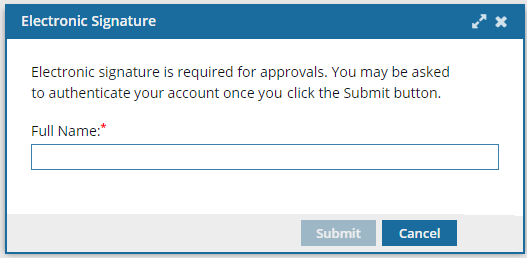
 Do not include underscores or email addresses. You must use the name as it appears in your user profile. For example: Jane Doe.
Do not include underscores or email addresses. You must use the name as it appears in your user profile. For example: Jane Doe.
 If you click Cancel on this screen, the review is marked as Completed and you cannot return to approve components or attach a signature.
If you click Cancel on this screen, the review is marked as Completed and you cannot return to approve components or attach a signature.
If you are asked to authenticate your account, after  , you must enter your Password.
, you must enter your Password.
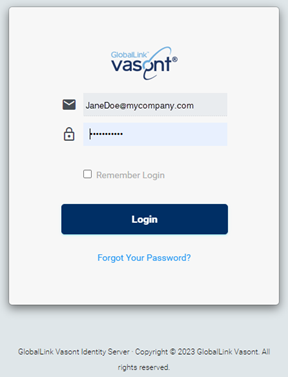
 Notes:
Notes:
You don't have to re-enter your user name. Inspire displays your account's email address for you.
You must use the same password that you log in to Inspire with.
If the name and password are validated, you see the approval as
 an electronic signature icon.
an electronic signature icon.- After you sign a component to approve it, your signature is attached to the component's history. Even if you Unapprove the component, it returns to the Draft state but the information about any previously attached e-signatures for approval remains part of the component's history.

Approve referenced components
If a component contains many referenced components, such as in a map, you can select the component and see a list of all referenced components. From this list you can approve a few or all referenced components at the same time.
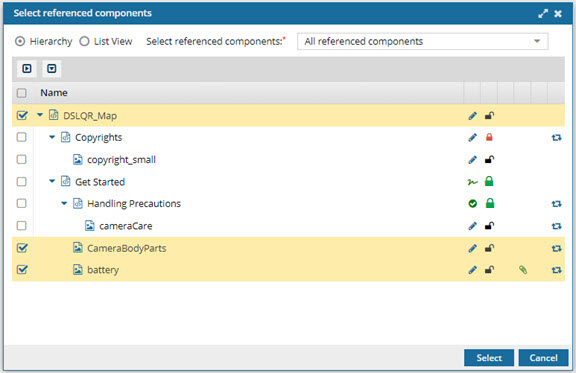
- You can access this feature from
 the Options menu.
the Options menu. - This feature is available in the Components browser only. It isn't available in a project.
- If an electronic signature is required, you can sign once for all selected referenced components.
- If an electronic signature is not required, you see the approved
 checkmark in front of all selected referenced components in the Components Browser.
checkmark in front of all selected referenced components in the Components Browser.

Unapprove a component
You can unapprove a component in the following places:
- Components browser: Look for any green icons before the name of the component.
- Oxygen map editor: Look for any green icons in the left Outline panel by an icon after the name of the component.
- Projects: From the right-click menu,
 the Options menu, and the Selected components panel.
the Options menu, and the Selected components panel.


 To unlock a component, you must have at least one of the following roles or permissions:
To unlock a component, you must have at least one of the following roles or permissions:
- Be an administrator.
- Non-admin users must be added to the Content Browser's can_unapprove module property.
Otherwise, you either cannot see the Unapprove option, or it is greyed out and unavailable.

 Content Browser: From the right-click menu,
Content Browser: From the right-click menu,  the Options menu, and the Selected components panel.
the Options menu, and the Selected components panel. Oxygen map editor: Look for any green icons in the left Outline panel by an icon after the name of the component.
Oxygen map editor: Look for any green icons in the left Outline panel by an icon after the name of the component. Projects: From the right-click menu,
Projects: From the right-click menu,  the Options menu, and the Selected components panel.
the Options menu, and the Selected components panel.

After you Unapprove the component, it returns to  the Draft state.
the Draft state.
- The system lock is removed.
- Any previously attached e-signatures for approval remainspart of the component's history.

Best practices
 When selecting a component to approve or unapprove, you can verify you're selecting the correct one by looking in two places:
When selecting a component to approve or unapprove, you can verify you're selecting the correct one by looking in two places:
- Components browser. You can look in the following columns:

- State
 Draft
Draft  Approved (no signature required)
Approved (no signature required) Approved (with a signature attached)
Approved (with a signature attached)
- eSigned Date. Hidden by default.
- eSigned By. Hidden by default.
To show these columns:
- Select any column heading.
- Click
 the menu arrow.
the menu arrow. - Select Columns.
- Select the checkbox for eSigned Date and eSigned By.
- State
- More component information panel. You can use this panel to see a Preview of the content.
 The Preview pane is always shown no matter which tab you select.
The Preview pane is always shown no matter which tab you select.- Use the scroll bar to see more content in the preview.
- You can collapse the Preview pane if you want to make more space for the Details or Where used pane.
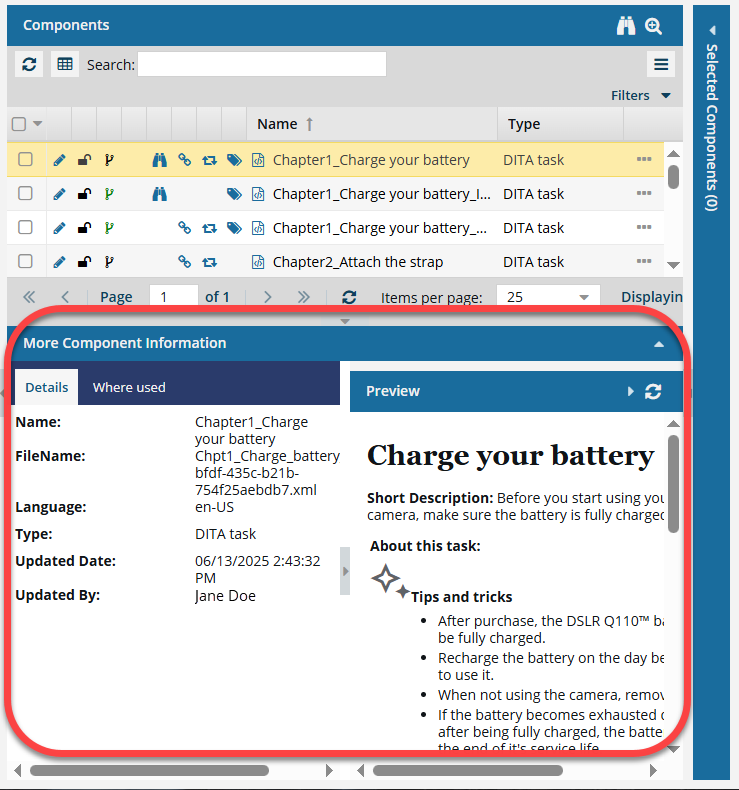
- Details: See file management details such as the Name with and without the GUID, the Language the content is written in, the content structure Type, when it was last updated, and the user who made the changes.
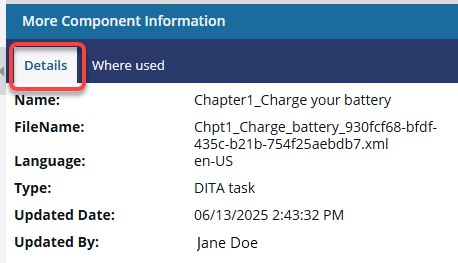
- Where used: View a list of all components that reference the selected component. This is the same information you see when you use
 the Options menu to select Details... and then select the Where used tab.
the Options menu to select Details... and then select the Where used tab.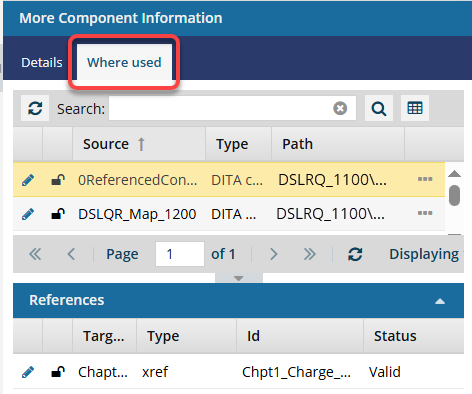
If the panel isn't open, to expand it, click
 the down arrow in the panel's title bar.
the down arrow in the panel's title bar. 

 When using the approval state, keep the following issues in mind:
When using the approval state, keep the following issues in mind:
- Before you approve a component, do all of the following to prevent seeing errors:
- Remove all tracked changes or comments. Follow the steps in: Work in the Oxygen editor.
- Validate the component's XML and correct any errors. Follow the steps in: Validate XML in the editor or Validate XML from the Component tab.
- Make sure the component is unlocked before approving.
- After you sign a component to approve it, your signature is attached to the component's history. Even if you or another user then Unapprove the component, it returns to the Draft state but the information about any previously attached e-signatures for approval remains part of the component's history.
- For more information read: View a component's history.